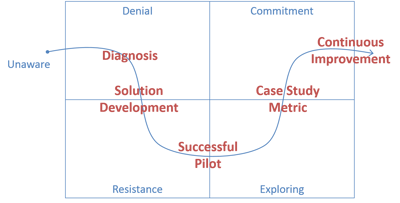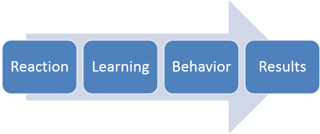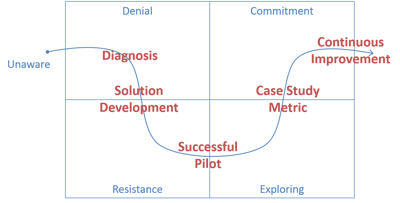The first attempt to implement Lean product development is critical. If you don’t get it right, there will be more resistance on the next attempt. Getting a successful pilot isn’t rocket science, but there are a few things you must know in order to prevent failure.
Four Ways to Ensure Your Lean Product Development Initiative Won't Fail
In the last post on cultural resistance to change I explained why successful pilots are a key step on your path to process improvement. In this post I will outline the most common pitfalls impacting Lean Pilots and how to avoid them.
The phases of change
To get started, let’s review the solution steps in the phases of change diagram.

It should be clear that you need to have a successful pilot that yields measurable business results in order to prove its effectiveness and continue with the next initiative. But what the diagram doesn’t show is what’s necessary within the pilot to create those results.
Fortunately, there’s a model that makes this process easier to understand. It comes from the Kirkpatrick model for evaluating training effectiveness and is outlined in the image below.

If you view it backwards (from right to left), it shows that in order to get results, you need to change behavior. And in order to change behavior, people need to learn something. And finally, in order to learn something, people need to have a good reaction to the training.
This should sound logical, but there’s a hidden stumbling block.
Just because someone learns something, doesn’t mean they will change their behavior!
Think about that. Have you ever seen people go to training and come back excited, but a few weeks later, there’s no evidence of any change?
It’s actually quite common. There’s a reason most training doesn’t work, but it’s not because it was “bad training."
So how do we get people to actually change their behavior?
There’s a good solution for this that we learned from a book written by Charles Fred called, Breakaway: Deliver value to your customers—fast!

In it Mr. Fred describes the four phases of learning:
- Introduction – when you first hear about the topic
- Assimilation – attend the class and learn more about the topic
- Translation – learn how to apply it to your specific job
- Accumulation of Experience – do the new thing until it becomes habit
Most companies stop with step two—they send someone to a general class. Some training programs go to step three and teach the students how to apply the knowledge at work.
But very few companies go to step four and actually coach, or otherwise enable, the students in the new behavior until they have reached proficiency.
That’s too bad because Charles Fred makes it clear:
There is a minimum threshold of experience necessary for new behaviors to become habit!
How much “experience” does it take?
The amount of practice it takes for new experiences to become habit depends on a lot of things:
- How different is the new behavior from the old one?
- How difficult is it to perform?
- How quickly and clearly does the person perceive the benefit?
- Are there other controls in place?
Basically, the higher the “benefit to cost ratio,” the quicker people will adopt new behaviors. But people still have to get to a certain amount of time to practice the new behavior before it can expected it to stick.
4 Ways to Ensure your Lean Product Development Initiative Won't Fail
Let’s review the solution phases laid out on the phases of change diagram again.

In order to ensure success on your first initiative, you must follow four key steps:
-
Achieve Measurable Business Results
Do something that will give you measurable business results. You’ll need those metrics to get approval for the next initiative.
-
Run a Pilot
Pick a solution that can be piloted quickly and with a small team. Solutions that involve a lot of people, or take a long time to get results, often fail due to lack of inertia even though they might be good solutions. (A good idea at the wrong time is still a bad idea.)
-
Create Behavioral Change
Recognize that the goal of training is to create behavioral change.
-
Ensure Activities Become Habit
Be sure to facilitate enough coaching and practice so that the new behaviors are thoroughly adopted as habit.
If you do those things right the first time, you will have broken the cultural barrier and set your company on the path for continuous improvement!
By the way, when we implement Playbook, we get the pilot team up and running with a day of training, and two weeks of coaching.
Can a pilot that short actually lead to business results?
Listen to this case study of how one company cut their industry average development time by 73% on their pilot project. (You read that correctly. They literally cut their development time from seven and a half months to two months on their first project...!)
But if you think that’s good, wait till you read what they did on their second project. Be sure to listen to the brief (1 min 26 sec) audio recording.
Related articles
Guide to Lean Project Management
Guide to Lean Product Development
Science and economics behind “failing fast”
Lean Product Development the Opportunity of the Century.
Lean Product Development Case Study
Principles of Lean Product Development
Lean Product Development Value Chain
Get started with Lean Product Development
Lean Product Development: Cultural Resistance
4 ways to Ensure Your Lean product Development Initiative Won't Fail



